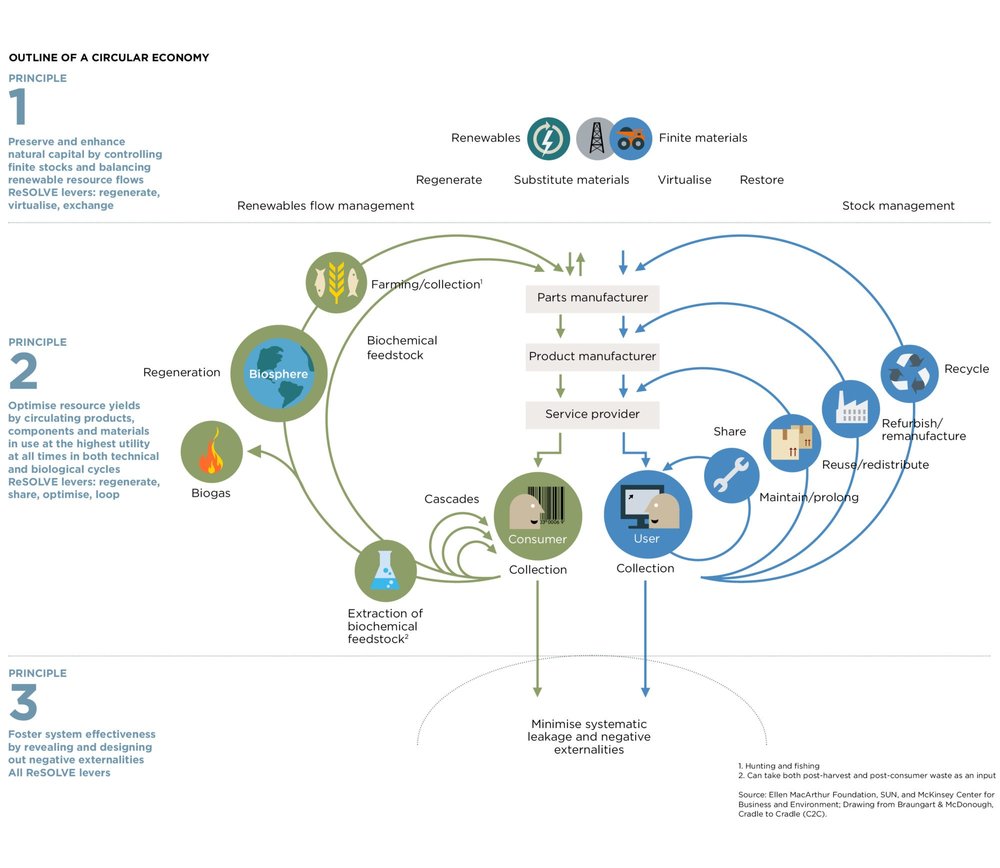What do you think of when you hear the term “zero waste”? Mason jars filled with bulk foods, coffee in glass cups, reusable dish towels? While these are all accurate representations of how individuals are reducing waste in their personal lives (particularly individuals on social media), it isn’t an accurate representation of what zero waste actually is or what the term actually means.
The term “zero waste” originated as a term to describe an economic system that averts creating waste. This economic system, otherwise known as a circular economy, is a closed loop system that reuses, recycles, and/or composts all of the “waste” in the economy and puts it back into the system of production. Materials are never sent to a landfill- they’re always being used in some capacity. A circular economy aims to reflect all of the efficient, closed loop systems (like nutrient recycling) that we see in nature.
A circular economy also emphasizes selling services rather than products to allow for better maintenance and material recovery from manufacturers. For example, selling light as a service rather than a product. Instead of selling light-bulbs and the energy needed to power them separately, one company streamlines the process and sells light- including the bulbs and the energy- as a whole. This way, when the bulbs need replacing, the company that sells this service can recover the old bulbs to recycle them whilst they install new ones. This model vastly reduces waste, saves companies money by reusing resources, and is generally more efficient.
A circular economy is in great contrast to the linear economy we currently live in, where the life of a material begins at production and ends at landfill disposal. Resources and materials are generally used once to produce a single product, and then are sent to a landfill. Material and resource recovery rates are low, and very rarely are they moved back into the system of production to have a new life. This linear system results in a lot of waste, a lot of emissions, and is just generally unproductive.

“Circular Economy System Diagram” from the Ellen MacArthur Foundation
IS A ZERO WASTE ECONOMY POSSIBLE?
Truly achieving a zero waste economy would require a complete overhaul of our current linear system. However, individuals and companies are taking personals steps to reduce their waste and adopt a circular mindset, inching our linear world closer to a circular one. This zero waste movement is spreading like wildfire, transforming individuals and businesses alike.
This zero waste movement can be largely attributed to the rise of zero waste influencers on social media. These “zero wasters” reduce their waste to a minimum by avoiding single-use, non-biodegradable packaging. Through their blogs, Instagram accounts, and YouTube channels, they have spread a message about the benefits of going zero waste, and how adopting this circular mindset allows for an environmentally sustainable world. These influencers have put pressure on companies to adopt a circular mindset and alter their products into ones that avoid waste. The good news? Businesses are listening.
Groups like the Ellen MacArthur Foundation are bringing together business, the government, and academia in order to achieve a circular economy. They partner with big names like Google, Philips, and SC Johnson to help educate the world on what a circular economy is and how it can make businesses more profitable. They also advocate for a performance economy, which focuses on selling services rather than products
Loop, a global shopping platform, is working with big companies like Clorox, Febreze, Häagen-Dazs, and Pantene to sell products in reusable packaging. Consumers buy the products online through Loop, receive them in 100% reusable packaging, and once they’ve used up the products, they send the packaging back to Loop to be sanitized and reused.
Patagonia has become committed to repairing, reusing, and recycling its clothing as much as possible in an effort to be more sustainable. They are also making a lot of their products with polyester made from recycled plastic bottles, and are pushing other clothing companies to adopt similar circular practices to move towards zero waste.
So, yes, a zero waste economy is possible, and these companies and organizations are proving it. However, zero waste is still far from being a universally adopted business model. Pressure still needs to be put on individuals, companies, and governments to curb their waste and adopt a circular mindset in terms of production and disposal of goods. If you want to help push for a circular economy, you can curb your personal waste and support companies who are doing the same.

Kayla Guilliams
Is the blog manager for Zero Waste Club, combining her love for writing with her passion for all things environmental sustainability. She is currently a student at the University of North Carolina at Chapel Hill where she is studying journalism, environmental studies, and food studies in hopes of building a career in environmental activism. You can find her on Instagram as @kaylaguilliams.
